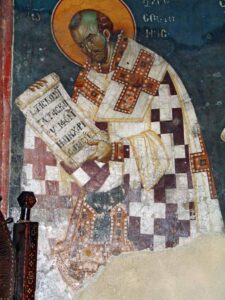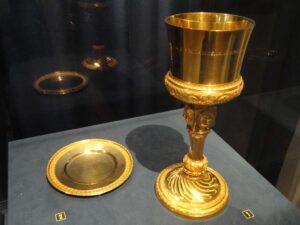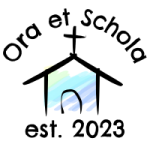Sharing is caring!
5 Science Lessons for the Feast of St. John Chrysostom
September 13th is the Feast of St. John Chrysostom. He lived from around 344 – 407, and was born in Antioch. He is one of the Greek Fathers of the Church and a Doctor of the Church.
Monk, Preacher, and Priest
He was a monk, preacher, and priest. He became the Bishop of Constantinople in 398. He urged his flock to assist at the Holy Sacrifice of the Mass. He once said:
“But you, when you see the priest offering the Sacrifice, consider not the priest who is ministering, but the hand of God invisibly outstretched.” – Saint John Chrysostom
Chrysostom Means “Golden mouth”
He was known an an expert orator, and spoke clearly and boldly about all aspects of the Faith, Christian life, and Scripture. His name, “Chrysostom,” means “golden mouth,” and he was given the name “Chrysostom” for his clear and thorough sermons. Some bishops in the hierarchy did not like his candid corrections, and even exiled him. He is the patron of orators, lecturers, preachers, speakers, and against epilepsy. The symbols associated with him are bees, a dove, and a pen.
St. John Chrysostom, pray for us!

5 Science Lessons for the Feast of St. John Chrysostom
Since “Chrysostom” means “golden mouthed,” let’s learn some fun facts about gold!
1. Learn the Atomic Properties of Gold
Here are some quick facts we can learn about gold by looking at the periodic table. With your student, find gold on the periodic table, and identify the following facts about gold:
- Gold is a transition metal. It can be found in the big, middle block of the table.
- The symbol for gold is Au. The symbol for gold comes from the Latin word “Aurum” which means “shining dawn” or “glow.”
- The atomic number for gold is 79. The atomic number tells us the number of protons in an atom’s nucleus.
- The atomic mass of gold is 196.97
- Gold is solid at room temperature.
- Gold is used in jewelry, coins, bullion, and electronics.
2. Go on a Golden Scavenger Hunt
Go around your home, and try to find as many gold objects as you can! How many can you find?
3. Learn About Where Gold Comes From
This video simply explains the theory behind where gold comes from! It’s quite surprising!
4. Learn About Panning for Gold
Learn how gold is panned. This is a quick video about the process. It’s so cool to see the gold come through at the end!
5. Why are chalices for Mass made of gold?
Did you know that gold has special properties that make it the perfect choice for holding the Precious Blood of Jesus? According to the General Instruction of the Roman Missal (Nos. 328-330), chalices for Mass must be made of gold (or gilded silver). Read about why chalices are made of gold. With your students, discuss the reasons why we use this precious metal to hold the Precious Blood of Our Lord!

Additional Ways to Celebrate the Feast of St. John Chrysostom
Have a snack of Golden Raisins or tea with Golden Honey while you read about this amazing Saint
Learn about the Doctors of the Church
Fun activity for students: Have them research a topic or teaching in the Church (such as, abortion, why we should attend Mass every Sunday, why we should receive the Sacrament of Confession, etc). Then, have each child present a persuasive 5-10 minute speech on the topic.
Liturgical Living Alerts
Want more specially tailored Feast Day ideas and reminders delivered straight to your inbox? Sign up for my Liturgical Living Alerts! These include seasonal Marian Hymns, special devotions, Novena reminders, appropriate Liturgical prayers, and simple recipes for your domestic church!
Sharing is caring!
